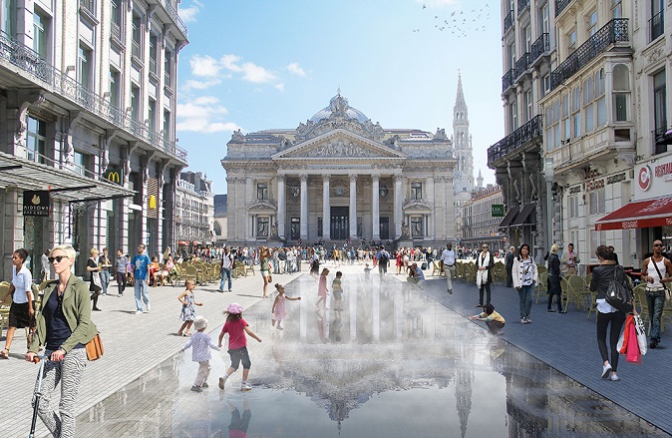Some of the world’s most traffic-choked cities are banning cars in key thoroughfares and transforming streetscapes to improve walkability.
From a pro-pedestrian makeover in Brussels to the installation of traffic lights on the footpath to catch the attention of phone users in a Dutch city, localities far and wide are experimenting with new ways to make their cities more walkable.
As the world’s population expands and emissions rise, cities are taking a hardline stance on congestion in a bid to boost the local economy, improve community wellbeing and lower emissions.
Just last week, Melbourne announced a plan to transform its city-streets by cracking down on car use and promoting walking in its city centre.
Brussels’ pro-pedestrian transformation
On the other side of the globe, the city at the centre of Europe’s diplomatic relations, Brussels, is undergoing an ambitious pedestrian-friendly makeover.
With a population of 1.2 million in a 161 square kilometre area, the Belgian city is one of Europe’s busiest cities.
But Brussels could soon be home to the second largest pedestrian zone in Europe after Venice under an ambitious plan to boost walkability and ban cars in major boulevards.
The massive pedestrian project has been underway in Brussels since 2014, where the city’s authorities are in the process of transforming the city’s main street to rival the famous Las Ramblas in Barcelona.
The project, which is due to be completed as early as this year or 2020, will see council turn the city centre into a car-free zone with more than 3000 square metres of green space in areas that were once busy crossroads.

While the city’s dainty walkways are already largely free from cars, the move has seen the city leaders take an even bigger jump and make permanent spaces for people to walk.
The project is set to transform the city’s landscape and includes the installation of graffiti-resistant paint on chairs, more drinking fountains, intelligent bins, energy-saving lights and 1,000 parking spaces for bikes.
The city’s ambitious plans can be seen in virtual reality through an online tool.
Data to boost pedestrian safety
Across the Atlantic Ocean, in Massachusetts, city-makers are taking pedestrian-friendly streetscapes a step further and using data to improve pedestrian safety.
Pedestrian fatalities in the United States are high, with more than 6,200 pedestrians killed by drivers last year.
The Massachusetts cities of Cambridge and Somerville hope to lower those statistics through investment in traffic analytics technology.

Both councils are using data to understand the factors behind pedestrian fatalities and quantify the risk to pedestrians as they cross the road.
Councils will then use the data to develop appropriate interventions and test their effectiveness.
The initiative comes as part of a broader bid from council to eliminate pedestrian fatalities under the Vision Zero program.
The city even has an interactive map showing the number of pedestrian fatalities and their exact location.
Dutch city’s traffic lights to help phone users
Back across the Pacific Ocean, the Dutch city of Bodegraven-Reeuwijk in 2017 took drastic measures to improve the safety of pedestrians, installing traffic lights on the footpath to catch the attention of distracted phone users.

The lights, which have been in place since 2017, have managed to improve locals’ awareness of traffic, with an observational study finding that pedestrians would stop for the lights.
The system embeds an LED strip into the pavement at busy crossings which blinks green or red to catch the attention of smartphone users.
The project, deemed + Light Line, was installed for the first time ever in the Dutch city, and aimed specifically at smartphone users who are not paying attention.
Comment below to have your say on this story.
If you have a news story or tip-off, get in touch at editorial@governmentnews.com.au.
Sign up to the Government News newsletter.




Leave a Reply